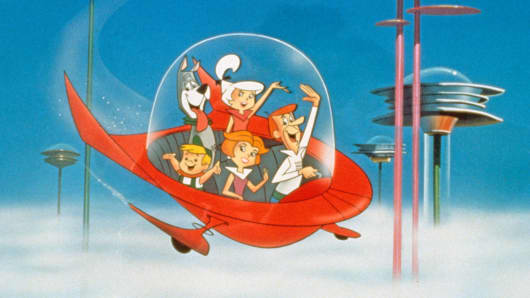Another major tech downdraft for flying cars is heat. Batteries, as everyone knows, get hot when you use them. And, unfortunately, the more power you draw from them over a shorter time period, the hotter they get. That's why your smartphone is hotter after watching a video than after a phone call of the same duration – watching video requires more energy.
The kind of short-burst energy needed to lift vehicle, batteries and humans skyward will produce enough heat to raise the battery pack temperature above safe levels for all kinds of components.
Unfortunately, most cooling systems for heat generating components are active systems that rely on pumping around liquids – the way the water pump, coolant tanks and a radiator keep a car engine cool. But that's a double-whammy for flying vehicles because active systems require energy to work – putting more stress on the battery – and are heavy – requiring more energy to lift.
The other option, passive cooling systems, have their own issues. Passive systems usually work by drawing heat away from a source and spreading it out to cool – most often across copper or aluminum plates. Passive systems to cool hot batteries in flying cars will require large surface area and, again, the added weight of lifting metal cooling plates off the ground.
To work, we will need much smaller, much lighter cooling solutions such as carbon fiber – one of solutions under development and study by NASA – which also has real issues with lifting batteries into flight and keeping them cool. (Disclosure – my company, KULR Technology, is the development partner with NASA on passive carbon fiber cooling solutions).
Finally, the batteries we have now just aren't safe enough.
Although it's rare, lithium-ion batteries fail. When they do, they create amazing levels of heat, fire and chemical gas discharges. With billions in use every day, this occurs somewhere regularly, occasionally with catastrophic consequences.
When battery failure happens in your cell phone, for example, your phone melts. That's a single battery cell. Just about everything larger than a smartphone – from laptops to cars – requires multi-cell battery packs – often 50 or 100 or more cells tightly packed together. Given the likely energy requirements of flying cars, they require thousands of battery cells in hundreds of packs.
When a lithium-ion battery fails in a multi-cell battery pack, it triggers its neighboring cells to fail too – a condition known as thermal runaway propagation. Think of it like a forest fire. It may start with one tree, but it spreads from tree to tree very quickly.
In thermal runaway propagation, things don't just melt, they explode. Violently. Watch this video of a multi-cell battery pack blowing apart a NASA test robot. Now imagine that in a flying car. That's why the Federal Aviation Administration has issued repeated, strict guidelines about even transporting multi-cell lithium-ion batteries, let alone using them in flight.
But it's actually worse than that.
We know that doing certain types of things to lithium-ion batteries makes them more likely to fail and trigger thermal runaway. Repeated cycling – charging and draining the battery, especially at high speed – is a danger. So is drawing excessive power from the battery in short bursts. Repeated bumps, lumps and physical damage to a battery can also make it more likely to fail.
Given that flying cars are likely to require high-energy, fast charging batteries and activities such as takeoff and landing are likely to draw massive power quickly, we'd be exposing batteries in flying cars to some of the very conditions that make them more likely to fail.
Maybe you can't tell, but as someone who works in emerging battery technology, I'm actually an optimist. When it comes to batteries, I think we'll get there – but we're at least five years away from demo stage and even further away from mass market. Making a flying car a reality requires more than a sense of knowing where we'd like to go - it requires knowing where we are.
Commentary by Michael Mo, the co-founder and CEO of KULR Technology, which develops carbon fiber cooling solutions for energy and technology. He has a master's in electrical engineering from University of California Santa Barbara and is a veteran business leader and investor in technology companies.
Disclosure: KULR Technology, is the development partner with NASA on passive carbon fiber cooling solutions.
Follow CNBC's Opinion section on Twitter @CNBCopinion.


